
Tonight's main event is the total lunar eclipse. Starting at about 6:00 PM, the Moon will move through the Earth's shadow.

The Moon will first encounter the penumbra, the outer portion of the shadow, which blocks only a portion of the solar disk. You may detect a slight dimming of the lunar surface as the Moon moves deeper into the penumbra. At around 7:00 PM, the Moon will start to enter the umbra, the central portion of the shadow. In this region, the Earth blocks the Moon's view of the Sun completely. However, a little sunlight manages to reach the Moon by travelling through the Earth's atmosphere, which bends it around the edge of the Earth. This refracted light is a deep red, for exactly the same reason that a sunset is deep red: red light penetrates the dusty, dirty, cloudy air of the Earth better than blue light. You should notice the Moon's drastic change in brightness and color as it creeps into the umbra. The show will reverse around 9:00 PM, as the Moon leaves the umbra and grows brighter. By 10:00 PM, it may be hard to notice anything out of the ordinary.
As the Moon moves through the Earth's shadow, it will become much dimmer than usual. Try using the text below to measure its brightness. Walk to an area far from any artificial light and hold the paper so that only moonlight falls upon it. How small is the smallest text you can still read?
Rutabega washing rice snow buckle.
Dry hat foosball calendar telephone piglet strand.
Elf win book game freeze bin test in the cough music throw fourth quarter.
Necromancer stinking boffo insipid crutch steal man drink eat insolent dripping bulb quandrary.